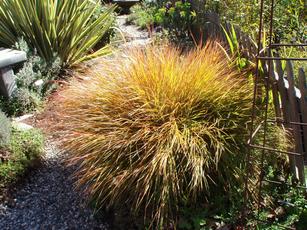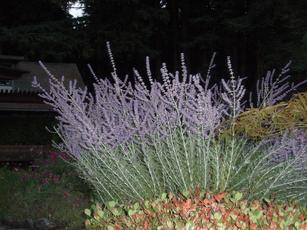Above the clear turquoise water of the Big Sur coastline, wildflowers still bloom in October. Bright orange Sticky Monkeyflower meander among a carpet of rosy blooming California Buckwheat. Deep orange California fuchsia flower on hillsides alongside the bright white flower heads of yarrow. They make a striking combination. Under the partial shade of pine trees lavender 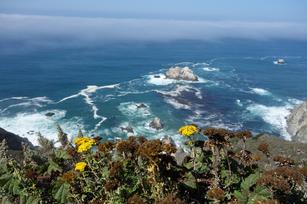 Seaside Daisy explode with color. Even poison oak contributes deep rusty-red tones to the landscape making it easier to identify and avoid. This wild land offers lessons and ideas to make our own gardens more beautiful.
Seaside Daisy explode with color. Even poison oak contributes deep rusty-red tones to the landscape making it easier to identify and avoid. This wild land offers lessons and ideas to make our own gardens more beautiful.
Big Sur has areas of chaparral, oak and pine woodlands, riparian or streamside woodlands and redwood-tanbark-oak woodlands. Nearly half of all the flora of California grows here and many northern and southern California plants mix in this unique location. . Only in Big Sur will redwoods and yuccas thrive together. The look is startling. Certainly not a combination you would think of for your own garden.
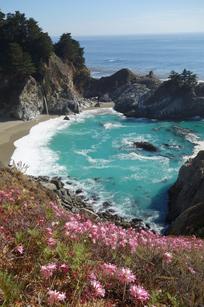 Near McWay Falls on Hwy 1, fragments of an elaborate stone house still remain along with some of the landscaping. Christopher McWay and his wife Rachel settled the area in the late 19th century.The land passed through several owners until former U.S. House of Representative Lathrop Brown and his wife Helen acquired it and built a beautiful stone structure overlooking McWay Cove. The house was torn down 50 years ago but many of the landscape plants still thrive after all these years. Hardy pittosporum eugenoides have survived without any supplemental watering. A huge stand of blooming Naked Ladies covers the rocky slope. We all know what survivors these bulbs are. Tall Mexican palms and ornamental trees surround the fragments of stone staircases and walls reminding us that nature will endure.
Near McWay Falls on Hwy 1, fragments of an elaborate stone house still remain along with some of the landscaping. Christopher McWay and his wife Rachel settled the area in the late 19th century.The land passed through several owners until former U.S. House of Representative Lathrop Brown and his wife Helen acquired it and built a beautiful stone structure overlooking McWay Cove. The house was torn down 50 years ago but many of the landscape plants still thrive after all these years. Hardy pittosporum eugenoides have survived without any supplemental watering. A huge stand of blooming Naked Ladies covers the rocky slope. We all know what survivors these bulbs are. Tall Mexican palms and ornamental trees surround the fragments of stone staircases and walls reminding us that nature will endure.
What allows all plants to thrive in their environment is the simple set of conditions that they like. It's nearly impossible to grow ferns in the hot sun around here and don't even think about trying a California fuchsia in the shade. Soil is important, too. Rich, moist soil is perfect for wild ginger but gravelly, well drained soil works best for Five-fingered ferns. Match the right plant with the right spot and you'll have success every time. Big Sur is a chock full of success stories.
Here are more tips for early fall in the garden.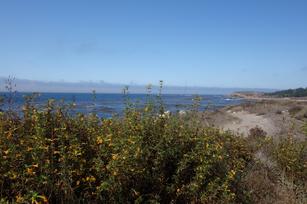
Fall is not a good time for major pruning. Wounds heal slowly, leaving them more susceptible to disease. As a general rule, don't prune when leaves are falling or forming. Wait to prune most trees until late in the dormant season or in late spring after leaves and needles form. To avoid sap flow on birches and maples, prune after leaves mature.
Do refresh perennials, such as butterfly bush, salvia and yarrow by cutting a third to half of their growth.
Rake leaves– compost or put in your green can. If large leaves are left in place they will mat down and set up fungal problems come spring.

